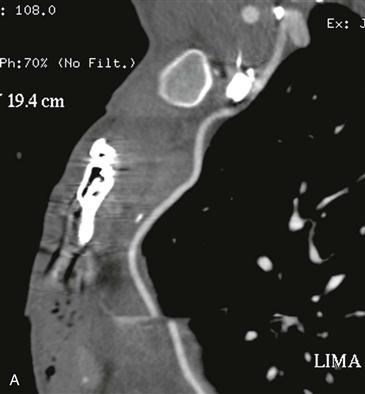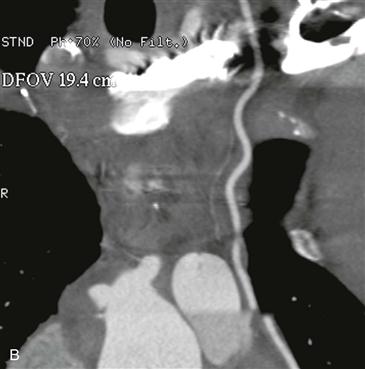CASE 16


1. Which of the following are artifacts seen on CT angiography? (Choose all that apply.)
A. Stepladder
B. Ghosting
D. Motion blur
2. What imaging artifact is shown?
B. Banding
C. Beam hardening from air bubble
D. Motion blur
3. What imaging plane is shown?
A. Coronal
B. Sagittal
C. Curved multiplanar reformat
D. Axial
4. What is the likely cause of the stepladder artifact?
ANSWERS
Reference
Choi HS, Choi BW, Choe KO, et al. Pitfalls, artifacts, and remedies in multi-detector row CT coronary angiography. Radiographics. 2004;24(3):787–800.
Comment
Causes
Motion-related artifacts fall into two categories: blurring or stepladder artifact. The right coronary artery is the most susceptible artery to blurring because it is the most mobile and rapidly moving coronary artery. There is a significant correlation between higher heart rates and poorer image quality secondary to blurring. This correlation forms the basis for use of beta blockade before coronary CT angiography. The goal resting heart rate is less than 60–65 beats/min.
Types of Stepladder Artifact
Stepladder artifact occurs whenever there is patient movement, respiration, or a varying heart rate. This artifact is identified by recognizing an abrupt linear offset of data (Figs. A and B). When stepladder artifact involves the anterior chest wall, it is due to respiration or patient movement and not a varying heart rate. Cardiac-related stepladder artifact can be reduced by minimizing the heart rate through the use of beta blockers and by choosing the appropriate reconstruction window within the R-R interval. Respiratory-related artifact or artifact related to voluntary motion is often easily prevented with careful patient instructions before imaging and oxygen for dyspneic patients.







